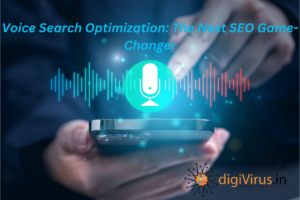If you’ve ever searched something on Google and clicked on the first few results, you’ve experienced the power of SEO—whether you knew it or not. SEO, or Search Engine Optimization, is the key to getting your website noticed online. In this guide, we’ll take you through everything you need to know about SEO from scratch, in simple language and with real-world relevance.
🌐 What is SEO?
SEO stands for Search Engine Optimization. It is the process of improving your website to increase its visibility when people search for products or services related to your business in search engines like Google, Bing, or Yahoo.
In short: Better SEO = Higher rankings = More traffic = More customers.
📈 Why is SEO Important?
Here are some compelling reasons:
- Visibility and Branding: When your site appears at the top of search results, more people see your brand.
- Credibility and Trust: People trust Google. If your site ranks high, people trust your business more.
- 24/7 Promotion: Unlike ads, SEO works even while you sleep.
- Cost-Effective: SEO brings in organic traffic—no need to pay per click.
- Higher ROI: SEO leads often convert better than other marketing strategies because they come from users actively searching for your services.
🔍 How Do Search Engines Work?
Search engines like Google use bots (also called crawlers or spiders) to scan websites across the internet. Here’s what happens:
- Crawling: Bots discover content on websites.
- Indexing: Google stores this information in its index.
- Ranking: When a user searches, Google ranks the most relevant content based on 200+ ranking factors.
Your goal? Make it easy for search engines to understand and rank your content.
🔐 Core Elements of SEO
SEO has three main categories:
1. On-Page SEO (Detailed)
On-Page SEO involves optimizing the content and HTML source code of a page. Here’s how:
- Keyword Optimization: Use target keywords naturally in headings, paragraphs, and URLs.
- Meta Tags: Write compelling and keyword-rich meta titles and descriptions.
- Headings (H1-H6): Use structured headings to organize your content and improve readability.
- Alt Text for Images: Describe images using keywords to boost accessibility and visibility in image searches.
- Internal Linking: Link to other pages on your site to guide visitors and search engines.
- URL Structure: Keep URLs short, descriptive, and keyword-rich.
- Content Quality: Ensure your content is informative, original, and provides real value to users.
2. Off-Page SEO (Detailed)
Off-Page SEO refers to external factors that influence your site’s ranking:
- Backlinks: Get quality links from authoritative and relevant websites.
- Guest Blogging: Write for other blogs in your industry to gain visibility and backlinks.
- Social Media Engagement: Share content and engage with your audience on platforms like Facebook, LinkedIn, Instagram.
- Influencer Marketing: Collaborate with influencers to generate content and backlinks.
- Directory Listings: Submit your site to relevant business directories like Yelp, JustDial, and others.
- Brand Mentions: Even if there’s no direct link, Google considers brand mentions as signals of authority.
3. Technical SEO (Detailed)
Technical SEO focuses on backend improvements that help search engines crawl and index your site:
- Website Speed: Optimize images, use caching, and a reliable host to reduce load times.
- Mobile Optimization: Ensure your website is responsive and functions well on all devices.
- SSL Certificate (HTTPS): Secure your site to build trust and meet Google’s ranking requirements.
- XML Sitemap: Create and submit an XML sitemap to help Google understand your site’s structure.
- Robots.txt File: Guide search engines on which pages to crawl and which to avoid.
- Fix Broken Links: Regularly audit and fix dead links or redirect errors.
- Structured Data Markup: Add schema to enhance search listings with rich results (like FAQs, reviews, prices).
4. Local SEO (Bonus for Small Businesses)
If you run a local business, this is a must. Local SEO includes:
- Optimizing your Google My Business profile
- Adding local keywords (e.g., “best bakery in Agra”)
- Getting local reviews
🚀 Beginner SEO Tips to Get Started
Here are some easy-to-apply tips for beginners:
- Start with Keyword Research: Use free tools like Google Keyword Planner or Ubersuggest.
- Create Quality Content: Write helpful, original blog posts and pages.
- Optimize Title Tags and Meta Descriptions: These appear in search results and impact click-throughs.
- Use Internal Links: Link your pages to each other to help Google understand your site structure.
- Get Backlinks: Share your content, collaborate with bloggers, or list your business in directories.
- Use Alt Text for Images: This improves accessibility and helps images show up in Google Images.
🚫 What SEO is NOT
- It’s not a quick fix—SEO takes time.
- It’s not about tricking Google, but aligning with what users are genuinely looking for.
- It’s not “set and forget”—regular updates are needed.
📊 Real-World Case Study: Local SEO Success
Business: Tile Store in Agra
Problem: Low online visibility, no website traffic
Strategy:
- Claimed and optimized Google My Business
- Added location-based keywords: “designer tiles in Agra”
- Got 20+ positive reviews
- Posted photos of real projects weekly
Result: Ranked in Google Maps’ top 3 within 45 days. Increased showroom visits by 60% in 2 months.
🌟 Final Thoughts
SEO is not magic; it’s strategy. It’s about making your website useful and relevant for both users and search engines. The earlier you start, the better your results over time.
Whether you’re a local business, eCommerce store, or personal brand, SEO is your ticket to long-term, sustainable growth online.
If you’ve ever searched something on Google and clicked on the first few results, you’ve experienced the power of SEO—whether you knew it or not. SEO, or Search Engine Optimization, is the key to getting your website noticed online. In this guide, we’ll take you through everything you need to know about SEO from scratch, in simple language and with real-world relevance.
🌐 What is SEO?
SEO stands for Search Engine Optimization. It is the process of improving your website to increase its visibility when people search for products or services related to your business in search engines like Google, Bing, or Yahoo.
In short: Better SEO = Higher rankings = More traffic = More customers.
📈 Why is SEO Important?
Here are some compelling reasons:
- Visibility and Branding: When your site appears at the top of search results, more people see your brand.
- Credibility and Trust: People trust Google. If your site ranks high, people trust your business more.
- 24/7 Promotion: Unlike ads, SEO works even while you sleep.
- Cost-Effective: SEO brings in organic traffic—no need to pay per click.
- Higher ROI: SEO leads often convert better than other marketing strategies because they come from users actively searching for your services.
🔍 How Do Search Engines Work?
Search engines like Google use bots (also called crawlers or spiders) to scan websites across the internet. Here’s what happens:
- Crawling: Bots discover content on websites.
- Indexing: Google stores this information in its index.
- Ranking: When a user searches, Google ranks the most relevant content based on 200+ ranking factors.
Your goal? Make it easy for search engines to understand and rank your content.
🔐 Core Elements of SEO
SEO has three main categories:
1. On-Page SEO (Detailed)
On-Page SEO involves optimizing the content and HTML source code of a page. Here’s how:
- Keyword Optimization: Use target keywords naturally in headings, paragraphs, and URLs.
- Meta Tags: Write compelling and keyword-rich meta titles and descriptions.
- Headings (H1-H6): Use structured headings to organize your content and improve readability.
- Alt Text for Images: Describe images using keywords to boost accessibility and visibility in image searches.
- Internal Linking: Link to other pages on your site to guide visitors and search engines.
- URL Structure: Keep URLs short, descriptive, and keyword-rich.
- Content Quality: Ensure your content is informative, original, and provides real value to users.
2. Off-Page SEO (Detailed)
Off-Page SEO refers to external factors that influence your site’s ranking:
- Backlinks: Get quality links from authoritative and relevant websites.
- Guest Blogging: Write for other blogs in your industry to gain visibility and backlinks.
- Social Media Engagement: Share content and engage with your audience on platforms like Facebook, LinkedIn, Instagram.
- Influencer Marketing: Collaborate with influencers to generate content and backlinks.
- Directory Listings: Submit your site to relevant business directories like Yelp, JustDial, and others.
- Brand Mentions: Even if there’s no direct link, Google considers brand mentions as signals of authority.
3. Technical SEO (Detailed)
Technical SEO focuses on backend improvements that help search engines crawl and index your site:
- Website Speed: Optimize images, use caching, and a reliable host to reduce load times.
- Mobile Optimization: Ensure your website is responsive and functions well on all devices.
- SSL Certificate (HTTPS): Secure your site to build trust and meet Google’s ranking requirements.
- XML Sitemap: Create and submit an XML sitemap to help Google understand your site’s structure.
- Robots.txt File: Guide search engines on which pages to crawl and which to avoid.
- Fix Broken Links: Regularly audit and fix dead links or redirect errors.
- Structured Data Markup: Add schema to enhance search listings with rich results (like FAQs, reviews, prices).
4. Local SEO (Bonus for Small Businesses)
If you run a local business, this is a must. Local SEO includes:
- Optimizing your Google My Business profile
- Adding local keywords (e.g., “best bakery in Agra”)
- Getting local reviews
🚀 Beginner Tips to Get Started
Here are some easy-to-apply tips for beginners:
- Start with Keyword Research: Use free tools like Google Keyword Planner or Ubersuggest.
- Create Quality Content: Write helpful, original blog posts and pages.
- Optimize Title Tags and Meta Descriptions: These appear in search results and impact click-throughs.
- Use Internal Links: Link your pages to each other to help Google understand your site structure.
- Get Backlinks: Share your content, collaborate with bloggers, or list your business in directories.
- Use Alt Text for Images: This improves accessibility and helps images show up in Google Images.
🚫 What SEO is NOT
- It’s not a quick fix—SEO takes time.
- It’s not about tricking Google, but aligning with what users are genuinely looking for.
- It’s not “set and forget”—regular updates are needed.
conclusion
SEO is not magic; it’s strategy. It’s about making your website useful and relevant for both users and search engines. The earlier you start, the better your results over time.
Whether you’re a local business, eCommerce store, or personal brand, SEO is your ticket to long-term, sustainable growth online.






